Yi Ru Wang
SAM2Act: Integrating Visual Foundation Model with A Memory Architecture for Robotic Manipulation
Jan 30, 2025



Abstract:Robotic manipulation systems operating in diverse, dynamic environments must exhibit three critical abilities: multitask interaction, generalization to unseen scenarios, and spatial memory. While significant progress has been made in robotic manipulation, existing approaches often fall short in generalization to complex environmental variations and addressing memory-dependent tasks. To bridge this gap, we introduce SAM2Act, a multi-view robotic transformer-based policy that leverages multi-resolution upsampling with visual representations from large-scale foundation model. SAM2Act achieves a state-of-the-art average success rate of 86.8% across 18 tasks in the RLBench benchmark, and demonstrates robust generalization on The Colosseum benchmark, with only a 4.3% performance gap under diverse environmental perturbations. Building on this foundation, we propose SAM2Act+, a memory-based architecture inspired by SAM2, which incorporates a memory bank, an encoder, and an attention mechanism to enhance spatial memory. To address the need for evaluating memory-dependent tasks, we introduce MemoryBench, a novel benchmark designed to assess spatial memory and action recall in robotic manipulation. SAM2Act+ achieves competitive performance on MemoryBench, significantly outperforming existing approaches and pushing the boundaries of memory-enabled robotic systems. Project page: https://sam2act.github.io/
AHA: A Vision-Language-Model for Detecting and Reasoning Over Failures in Robotic Manipulation
Oct 01, 2024



Abstract:Robotic manipulation in open-world settings requires not only task execution but also the ability to detect and learn from failures. While recent advances in vision-language models (VLMs) and large language models (LLMs) have improved robots' spatial reasoning and problem-solving abilities, they still struggle with failure recognition, limiting their real-world applicability. We introduce AHA, an open-source VLM designed to detect and reason about failures in robotic manipulation using natural language. By framing failure detection as a free-form reasoning task, AHA identifies failures and provides detailed, adaptable explanations across different robots, tasks, and environments. We fine-tuned AHA using FailGen, a scalable framework that generates the first large-scale dataset of robotic failure trajectories, the AHA dataset. FailGen achieves this by procedurally perturbing successful demonstrations from simulation. Despite being trained solely on the AHA dataset, AHA generalizes effectively to real-world failure datasets, robotic systems, and unseen tasks. It surpasses the second-best model (GPT-4o in-context learning) by 10.3% and exceeds the average performance of six compared models including five state-of-the-art VLMs by 35.3% across multiple metrics and datasets. We integrate AHA into three manipulation frameworks that utilize LLMs/VLMs for reinforcement learning, task and motion planning, and zero-shot trajectory generation. AHA's failure feedback enhances these policies' performances by refining dense reward functions, optimizing task planning, and improving sub-task verification, boosting task success rates by an average of 21.4% across all three tasks compared to GPT-4 models.
Manipulate-Anything: Automating Real-World Robots using Vision-Language Models
Jun 27, 2024Abstract:Large-scale endeavors like RT-1 and widespread community efforts such as Open-X-Embodiment have contributed to growing the scale of robot demonstration data. However, there is still an opportunity to improve the quality, quantity, and diversity of robot demonstration data. Although vision-language models have been shown to automatically generate demonstration data, their utility has been limited to environments with privileged state information, they require hand-designed skills, and are limited to interactions with few object instances. We propose Manipulate-Anything, a scalable automated generation method for real-world robotic manipulation. Unlike prior work, our method can operate in real-world environments without any privileged state information, hand-designed skills, and can manipulate any static object. We evaluate our method using two setups. First, Manipulate-Anything successfully generates trajectories for all 5 real-world and 12 simulation tasks, significantly outperforming existing methods like VoxPoser. Second, Manipulate-Anything's demonstrations can train more robust behavior cloning policies than training with human demonstrations, or from data generated by VoxPoser and Code-As-Policies. We believe \methodLong\ can be the scalable method for both generating data for robotics and solving novel tasks in a zero-shot setting.
NEWTON: Are Large Language Models Capable of Physical Reasoning?
Oct 10, 2023



Abstract:Large Language Models (LLMs), through their contextualized representations, have been empirically proven to encapsulate syntactic, semantic, word sense, and common-sense knowledge. However, there has been limited exploration of their physical reasoning abilities, specifically concerning the crucial attributes for comprehending everyday objects. To address this gap, we introduce NEWTON, a repository and benchmark for evaluating the physics reasoning skills of LLMs. Further, to enable domain-specific adaptation of this benchmark, we present a pipeline to enable researchers to generate a variant of this benchmark that has been customized to the objects and attributes relevant for their application. The NEWTON repository comprises a collection of 2800 object-attribute pairs, providing the foundation for generating infinite-scale assessment templates. The NEWTON benchmark consists of 160K QA questions, curated using the NEWTON repository to investigate the physical reasoning capabilities of several mainstream language models across foundational, explicit, and implicit reasoning tasks. Through extensive empirical analysis, our results highlight the capabilities of LLMs for physical reasoning. We find that LLMs like GPT-4 demonstrate strong reasoning capabilities in scenario-based tasks but exhibit less consistency in object-attribute reasoning compared to humans (50% vs. 84%). Furthermore, the NEWTON platform demonstrates its potential for evaluating and enhancing language models, paving the way for their integration into physically grounded settings, such as robotic manipulation. Project site: https://newtonreasoning.github.io
AR2-D2:Training a Robot Without a Robot
Jun 23, 2023Abstract:Diligently gathered human demonstrations serve as the unsung heroes empowering the progression of robot learning. Today, demonstrations are collected by training people to use specialized controllers, which (tele-)operate robots to manipulate a small number of objects. By contrast, we introduce AR2-D2: a system for collecting demonstrations which (1) does not require people with specialized training, (2) does not require any real robots during data collection, and therefore, (3) enables manipulation of diverse objects with a real robot. AR2-D2 is a framework in the form of an iOS app that people can use to record a video of themselves manipulating any object while simultaneously capturing essential data modalities for training a real robot. We show that data collected via our system enables the training of behavior cloning agents in manipulating real objects. Our experiments further show that training with our AR data is as effective as training with real-world robot demonstrations. Moreover, our user study indicates that users find AR2-D2 intuitive to use and require no training in contrast to four other frequently employed methods for collecting robot demonstrations.
MVTrans: Multi-View Perception of Transparent Objects
Feb 22, 2023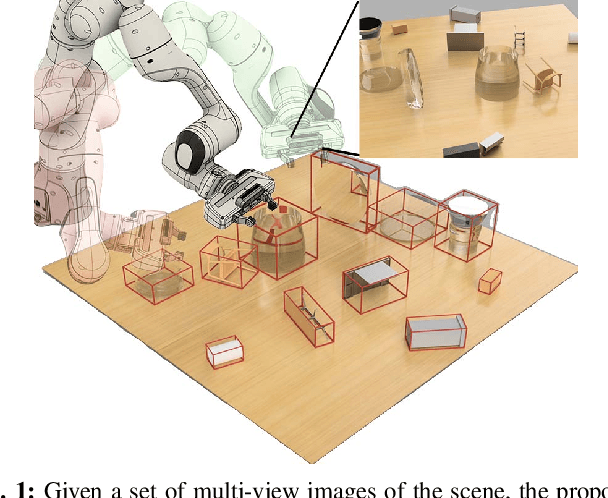

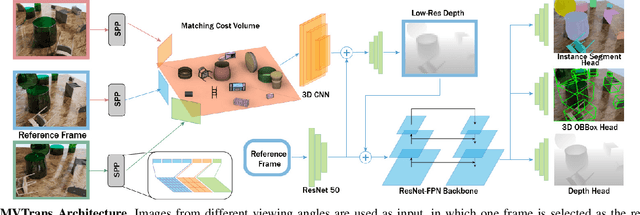

Abstract:Transparent object perception is a crucial skill for applications such as robot manipulation in household and laboratory settings. Existing methods utilize RGB-D or stereo inputs to handle a subset of perception tasks including depth and pose estimation. However, transparent object perception remains to be an open problem. In this paper, we forgo the unreliable depth map from RGB-D sensors and extend the stereo based method. Our proposed method, MVTrans, is an end-to-end multi-view architecture with multiple perception capabilities, including depth estimation, segmentation, and pose estimation. Additionally, we establish a novel procedural photo-realistic dataset generation pipeline and create a large-scale transparent object detection dataset, Syn-TODD, which is suitable for training networks with all three modalities, RGB-D, stereo and multi-view RGB. Project Site: https://ac-rad.github.io/MVTrans/
CONetV2: Efficient Auto-Channel Size Optimization for CNNs
Oct 13, 2021



Abstract:Neural Architecture Search (NAS) has been pivotal in finding optimal network configurations for Convolution Neural Networks (CNNs). While many methods explore NAS from a global search-space perspective, the employed optimization schemes typically require heavy computational resources. This work introduces a method that is efficient in computationally constrained environments by examining the micro-search space of channel size. In tackling channel-size optimization, we design an automated algorithm to extract the dependencies within different connected layers of the network. In addition, we introduce the idea of knowledge distillation, which enables preservation of trained weights, admist trials where the channel sizes are changing. Further, since the standard performance indicators (accuracy, loss) fail to capture the performance of individual network components (providing an overall network evaluation), we introduce a novel metric that highly correlates with test accuracy and enables analysis of individual network layers. Combining dependency extraction, metrics, and knowledge distillation, we introduce an efficient searching algorithm, with simulated annealing inspired stochasticity, and demonstrate its effectiveness in finding optimal architectures that outperform baselines by a large margin.
Seeing Glass: Joint Point Cloud and Depth Completion for Transparent Objects
Sep 30, 2021
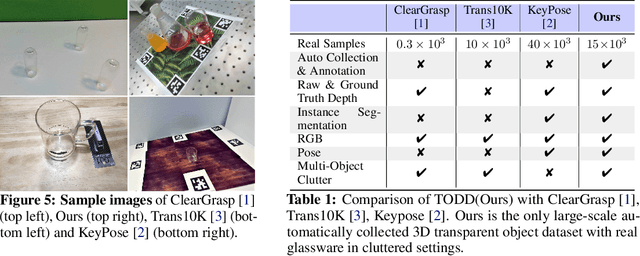
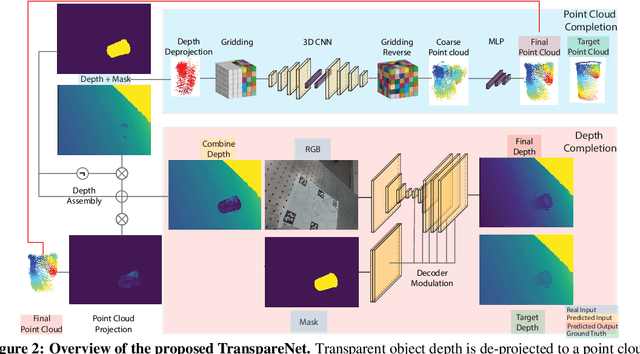
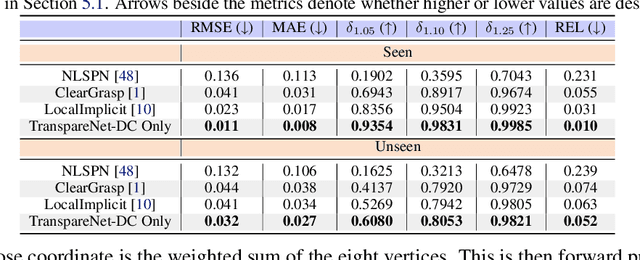
Abstract:The basis of many object manipulation algorithms is RGB-D input. Yet, commodity RGB-D sensors can only provide distorted depth maps for a wide range of transparent objects due light refraction and absorption. To tackle the perception challenges posed by transparent objects, we propose TranspareNet, a joint point cloud and depth completion method, with the ability to complete the depth of transparent objects in cluttered and complex scenes, even with partially filled fluid contents within the vessels. To address the shortcomings of existing transparent object data collection schemes in literature, we also propose an automated dataset creation workflow that consists of robot-controlled image collection and vision-based automatic annotation. Through this automated workflow, we created Toronto Transparent Objects Depth Dataset (TODD), which consists of nearly 15000 RGB-D images. Our experimental evaluation demonstrates that TranspareNet outperforms existing state-of-the-art depth completion methods on multiple datasets, including ClearGrasp, and that it also handles cluttered scenes when trained on TODD. Code and dataset will be released at https://www.pair.toronto.edu/TranspareNet/
Predicting 3D shapes, masks, and properties of materials, liquids, and objects inside transparent containers, using the TransProteus CGI dataset
Sep 15, 2021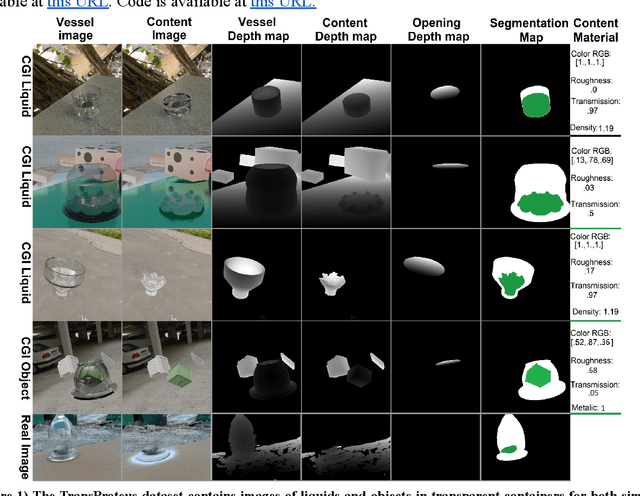
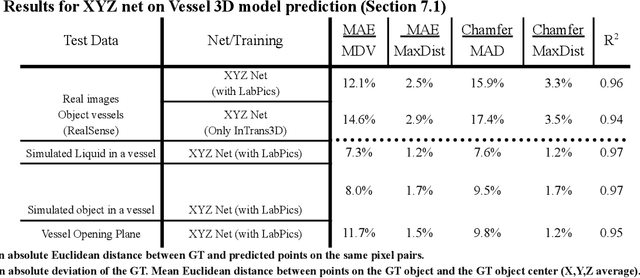
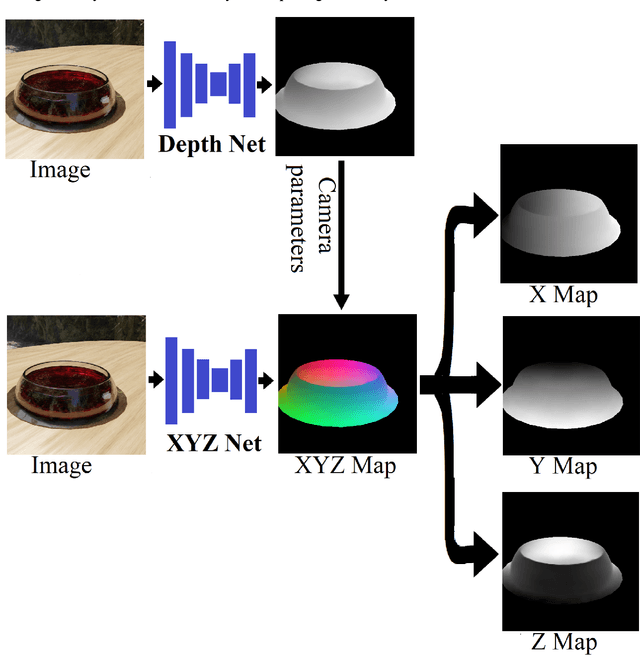
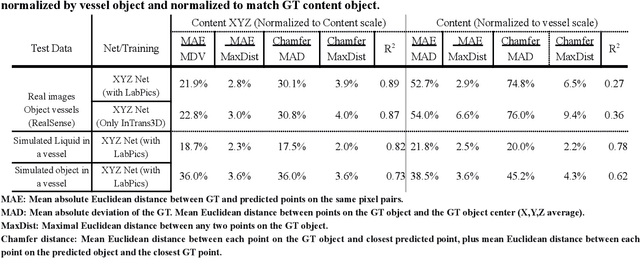
Abstract:We present TransProteus, a dataset, and methods for predicting the 3D structure, masks, and properties of materials, liquids, and objects inside transparent vessels from a single image without prior knowledge of the image source and camera parameters. Manipulating materials in transparent containers is essential in many fields and depends heavily on vision. This work supplies a new procedurally generated dataset consisting of 50k images of liquids and solid objects inside transparent containers. The image annotations include 3D models, material properties (color/transparency/roughness...), and segmentation masks for the vessel and its content. The synthetic (CGI) part of the dataset was procedurally generated using 13k different objects, 500 different environments (HDRI), and 1450 material textures (PBR) combined with simulated liquids and procedurally generated vessels. In addition, we supply 104 real-world images of objects inside transparent vessels with depth maps of both the vessel and its content. We propose a camera agnostic method that predicts 3D models from an image as an XYZ map. This allows the trained net to predict the 3D model as a map with XYZ coordinates per pixel without prior knowledge of the image source. To calculate the training loss, we use the distance between pairs of points inside the 3D model instead of the absolute XYZ coordinates. This makes the loss function translation invariant. We use this to predict 3D models of vessels and their content from a single image. Finally, we demonstrate a net that uses a single image to predict the material properties of the vessel content and surface.
 Add to Chrome
Add to Chrome Add to Firefox
Add to Firefox Add to Edge
Add to Edge